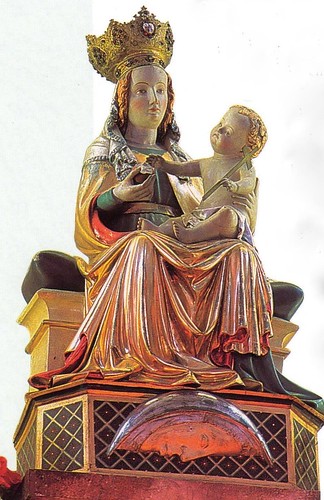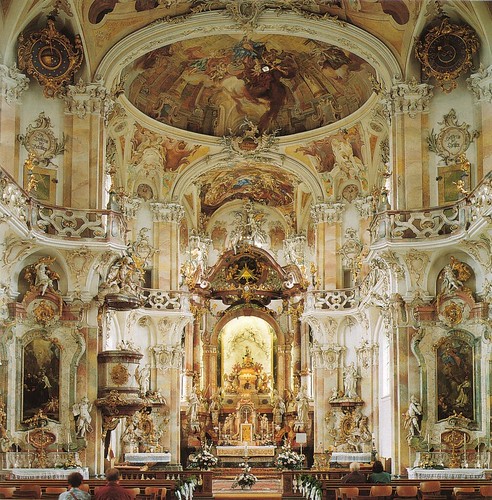
Since 1790 the statue of the Mother of God, especially highlighted as a focal point of the shrine and as the mediatrix of all grace, has been shining like a pearl in an oyster at the center of this classical monument which is the high altar. According to experts and admirers this image of Our Lady of Birnau, which is part of the group of "beautiful Madonnas", merits the title of "most beautiful enthroned statue of Mary in upper southern Bavaria". The great fresco overhanging the church nave is also devoted to this image. Angels can be seen introducing the miraculous statue into the new sanctuary in order to heighten its prestige and perpetuate the tradition of Marian devotion in Old-Birnau.
The sculpture measures roughly one meter in height. The soft drape of the clothing and the deep folds between the feet indicate a Gothic work of about 1430. According to the research of Jurgen Michler the Birnau statue is comparable to statues which came into being in Ulm during the years 1420-1436. Crafted and decorative stone sculptures of the façade of the cathedral of Ulm help to establish stylistic kinships (both in terms of decorative technique and plastic beauty) between the Virgin of Birnau and the Ulm school, especially the "master of the Dornstadt altar". Since, furthermore, a written source from 1430 testifies to the activity in Uberlingen of a "master of Ulm", it is not difficult to situate the style of our statue in the same period of the history of art. What, on the other hand, remains obscure is the reason why a new statue of the Virgin was made around 1430 for the pilgrimage of Old-Birnau. What had happened to the first miraculous statue? It seems that, if the "mellow style" of the present work bears without a doubt the mark of Gothic art, the sculptor was probably inspired by a seated model of a Romanesque Madonna. One naturally thinks of the previous statue from Birnau. In addition, the typological features of the old miraculous statue from the hermitage, often imitated, show through in the Gothic Birnau copy. What was new in the region around Lake Constance around 1430 was the use of the crescent moon motif at the feet of sculptures representing the Virgin (cf. the Madonna of Eriskirch, 1410). This half moon fitted around the face of the woman of the Apocalypse has to be seen in parallel with the radiating nimbus placed behind the seated figure, which has now disappeared (cf. the representation of the miraculous statue by Christopher Lienhard, 1708). The rays of sunlight (light and warmth of God) and the moon help us to recognize in Mary this woman of the Apocalypse who has existed from time immemorial in the plan of salvation of God as mother of the Savior and mediatrix of all grace (Ap 12:1-5). In the footsteps of Christian Antiquity the Middle Ages readily used the sun and the crescent moon as symbols of the royalty of Christ. In the Baroque era this allegory was also applied to Mary, due to the fact that the moon reflects the light of the sun.
In 1746 the miraculous statue of Old-Birnau was transferred, with a subterfuge, to the abbey of Salem, whence in 1750 it reached its place in the new sanctuary beside the lake. "Our Lady" holds her son, the Word of God made man, majestically on her knees. She presents her son for the salvation of the world. Around 1900 two restoration artists from Uberlingen, the Mezger brothers, replaced the hands and the lost attributes of the two figures and gave them a new coloring. Similarly the gestural symbols were added at the beginning of the 20th century according to ancient models: the bitten apple as an allusion to the original sin as well as the little cross of the child Jesus represent the symbols of the salvation wrought by Christ.

Mary, star of the sea
"You who feel far from firm ground, carried off by the waves of this world amidst the storms and tempests, if you do not wish to founder, do not let your gaze waver from the light of this star. If the winds of temptation rise up, if you run into the rocks of tribulation, look at the star, invoke Mary. If you are shaken about by the waves of pride, ambition, betrayal or jealousy, look at the star, invoke Mary. If anger or avarice or impure desires toss about the little boat of your soul, look at Mary. If you are troubled by the enormity of your crimes, ashamed of the grubbiness of your conscience, frozen with terror at the thought of judgment, or if you begin to be engulfed by the abyss of sadness, by the depths of despair, think of Mary. In danger, in anguish, in doubt, think of Mary, invoke Mary."
(Extract of a sermon of Saint Bernard of Clairvaux)


